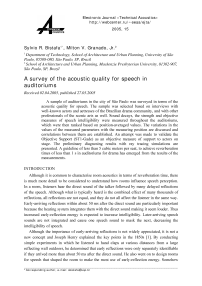A survey of the acoustic quality for speech in auditoriums
Автор: Bistafa Sylvio R., Granado Milton V.
Журнал: Техническая акустика @ejta
Статья в выпуске: т.5, 2005 года.
Бесплатный доступ
A sample of auditoriums in the city of São Paulo was surveyed in terms of the acoustic quality for speech. The sample was selected based on interviews with well-known actors and actresses of the Brazilian drama community, and with other professionals of the scenic arts as well. Sound decays, the strength and objective measures of speech intelligibility were measured throughout the auditoriums, which were then ranked based on position-averaged values. The variations in the values of the measured parameters with the measuring position are discussed and correlations between them are established. An attempt was made to validate the Objective Support (ST1-Gade) as an objective measure of support to actors on stage. The preliminary diagnosing results with ray tracing simulations are presented. A guideline of less than 5 cubic meters per seat, to achieve reverberation times of less than 1 s in auditoriums for drama has emerged from the results of the measurements.
Короткий адрес: https://sciup.org/14316240
IDR: 14316240
Список литературы A survey of the acoustic quality for speech in auditoriums
- R. S. Shankland. Architectural acoustics in America to 1930. J. Acoust. Soc. Am., 1977, 61(2), 250-254.
- H. Haas. Uber den einfluss des einfachechos auf die horsamkeit von sprache. Acustica, 1951, 1, 49-58.
- R. D. Fay, W. M. Hall. Historical notes on the Hass effect. J. Acoust. Soc. Am., 1956, 28, 131-132.
- F. Aigner, M. J. O. Strutt. On the physiological effect of several sources of sound on the ear and its consequences in architectural acoustics. J. Acoust. Soc. Am., 1935, 6, 155-159.
- J. P. A. Lochner, J. F. Burger. The influence of reflections on auditorium acoustics. J. Sound Vibr., 1964, 1(4), 426-454.
- R. Thiele. Richtungsverteilungs und zeitfolge der schallruckewurfe in raumen. Acustica, 1953, 3, 291-302.
- J. S. Bradley. Relationships among measures of speech intelligibility in rooms. J. Audio Eng. Soc., 1998, 46, 396-405.
- H. G. Latham. The signal-to-noise ratio for speech intelligibility -An auditorium acoustics design index. App. Acoust., 1979, 12, 253-320.
- IEC Std. 60268-16. Objective rating of speech intelligibility by the Speech Transmission Index. 2nd ed., International Electrotechnical Commission, Geneva, Switzerland (199803).
- S. R. Bistafa, J. S. Bradley. Revisiting algorithms for predicting the articulation loss of consonants Alcons. J. Audio Eng. Soc., 2000, 48, 531-544.
- S. R. Bistafa, J. S. Bradley. Reverberation time and maximum background-noise level for classrooms from a comparative study of speech intelligibility metrics. J. Acoust. Soc. Am., 2000, 107(2), 861-875.
- Barron M. Auditorium Acoustics and Architectural Design. London, E -FN SPON, 1993.
- J. S. Bradley, S. R. Bistafa. Relating speech intelligibility to useful-to-detrimental sound ratios (L). J. Acoust. Soc. of Am., 2002, 112(1), 27-29.
- T. Houtgast, H. J. M. Steeneken. A multi-language evaluation of the RaSTI-Method for estimating speech intelligibility in auditoria. Acustica, 1984, 54, 185-199.
- A. C. Gade. Investigations of Musicians' Conditions in Concert Halls. II: Field Experiments and Synthesis of Results. Acustica, 1989, 69, 249-262.


